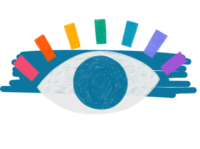
As parents, we often marvel at the world through the eyes of our children. Their sense of wonder and curiosity is boundless, and their view of the world is a unique and evolving experience. But have you ever wondered how a child sees? In this blog post, we’ll delve into the fascinating world of a child’s vision, exploring the development of their visual system, common vision milestones, and the importance of pediatric eye care.
How Does Vision Develop in Children?
- Newborn Vision: At birth, a baby’s vision is quite limited. They can see objects and people up close, but their distance vision is blurry. Their color perception is also limited, and they prefer high-contrast patterns.
- Visual Development in the First Year: Over the first few months, a baby’s visual system rapidly matures. By around six months, they can focus on objects at different distances and track moving objects. Color vision continues to improve.
- Depth Perception: Depth perception, or the ability to perceive the three-dimensional world, begins to develop around six to seven months. This is when babies start to understand spatial relationships and distances.
- Toddler Vision: As toddlers grow, their vision continues to improve. They become more skilled at recognizing shapes and objects, and their color vision becomes more like that of an adult.
- Preschool Years: By the time a child reaches preschool age, their visual system is quite developed. They can recognize letters, numbers, and shapes, setting the stage for early learning.
Common Vision Milestones in Childhood
Understanding the typical visual milestones in a child’s development is essential for ensuring their eyes are healthy and their vision is on track. Here are some key milestones:
- Newborn Eye Exam: Newborns should undergo a basic eye examination to check for any obvious issues, such as cataracts or congenital eye conditions.
- Infant Eye Exams: Regular check-ups with a pediatric ophthalmologist or optometrist can help identify and address issues like lazy eye (amblyopia) and crossed eyes (strabismus).
- Preschool Vision Screening: Many schools conduct vision screenings to detect common vision problems like nearsightedness (myopia) or farsightedness (hyperopia).
- Reading and Learning: Recognizing letters and numbers, as well as tracking words on a page, are crucial for school readiness.
The Importance of Pediatric Eye Care
Regular eye check-ups are essential for monitoring a child’s vision development and identifying any potential issues early. Early intervention can prevent vision problems from becoming more serious and can significantly impact a child’s quality of life.
Pediatric ophthalmologists and optometrists are trained to work with children and provide a child-friendly environment. They can perform comprehensive eye exams, prescribe glasses if needed, and recommend therapies or treatments for conditions like amblyopia or strabismus.
In Conclusion: Understanding how a child sees and recognizing the importance of their visual development is crucial for parents and caregivers. Regular eye check-ups and early intervention can ensure that your child’s eyes are healthy, setting them on a path to explore the world with clarity and confidence. If you have any concerns about your child’s vision, don’t hesitate to consult a pediatric eye specialist who can provide expert guidance and care.
